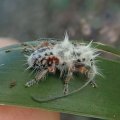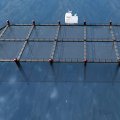A gene responsible for building muscle tissue in monarch butterflies is the key to their annual mass migration, according to a study from an international team of researchers.
The University of Queensland’s Professor Myron Zalucki, an author on the study, said the research uncovered the secrets of the monarch butterfly’s spectacular migratory behavior and distinct orange colour.
“These results have prompted a revision of the evolutionary history of this species and provided a few surprises about the genes that are responsible for certain traits,” Professor Zalucki said.
“This work emphasises the importance of further study into gene-environment interactions to help conservation efforts for declining species.”
The study traced the history of the monarch butterfly, Danaus plexippus, from its expansion at the end of the last glacial maximum 20,000 years ago to the current widespread decline.
Each year a population of monarch butterflies migrate in great masses from southern Canada to Mexico, but numbers have fallen in recent years.
The team sequenced the genomes of 92 monarch specimens from around the world and nine specimens of other butterfly species.
“Our results suggest that the monarch butterfly originated in North America from a migratory ancestor and spread across the globe, with some populations maintaining migratory behavior and others becoming non-migratory,” Professor Zalucki said.
A single gene, Collagen IV alpha-1, was identified as having a strong influence on migratory behaviour by building muscle tissue and making metabolism more efficient in the migratory monarch populations.
The researchers also found that wing colour variation was decided by the myosin gene DPOGS206617, which has never before been connected with pigmentation in insects.
“One of the ongoing challenges in biology is to work out the contribution of genes and environment to the behaviour and biology of animals,” Professor Zalucki said.
“We need a greater understanding of gene-environment interactions to extend our knowledge about the extraordinary evolutionary history of this iconic butterfly and other threatened species.”
Professor Zalucki said the results showed how the monarch butterfly populations had evolved when introduced to new areas and how they might evolve when habitats change.
“We’re seeing drastic changes to landscapes which force populations to adapt, migrate or perish,” he said.
“The famous mass migration of the monarch is under threat due to habitat changes and scarcity of milkweed host plants.”
The research, published this week in Nature, was a collaboration with the Chinese Academy of Sciences, the University of Chicago, the University of Massachusetts Medical School, Stanford University, the University of Helsinki, Universidad de Córdoba, the University of Georgia and Emory University.
Media: Professor Myron Zalucki, 07 3365 1747, m.zalucki@uq.edu.au or Engagement Officer Aimee Parker, 07 3346 1629, a.parker3@uq.edu.au.
A brief video on monarch migration can be seen here: http://www.discovery.com/tv-shows/life/videos/monarch-butterfly-winter-migration.htm.












